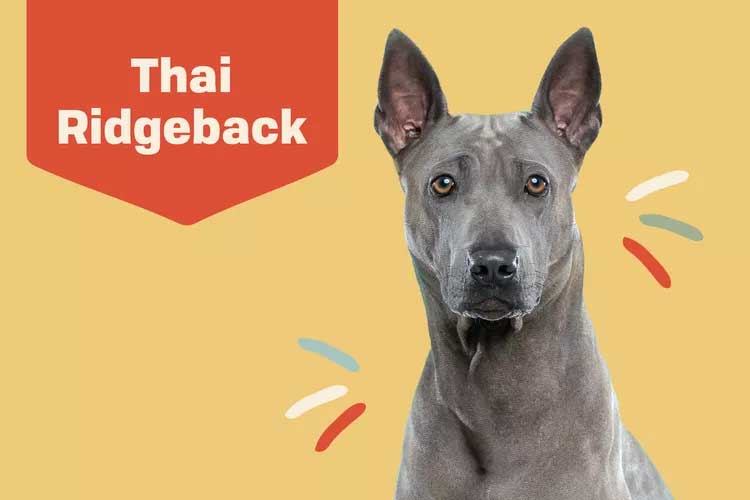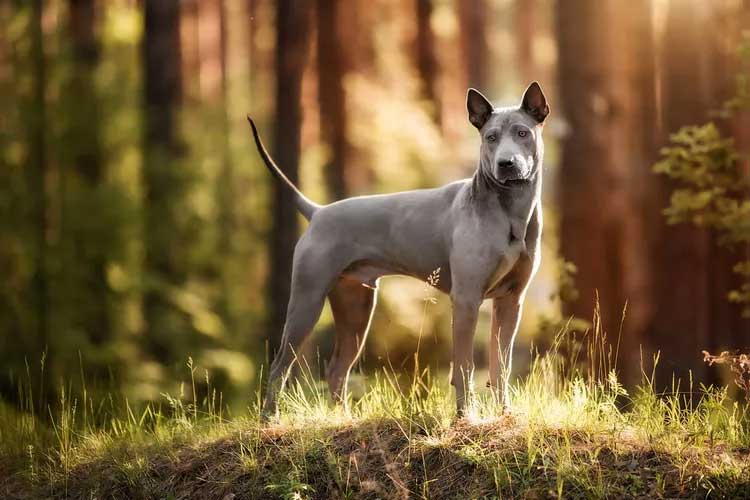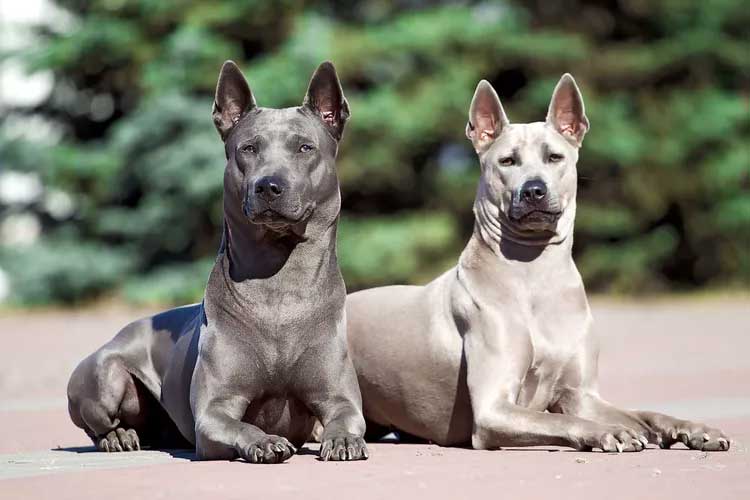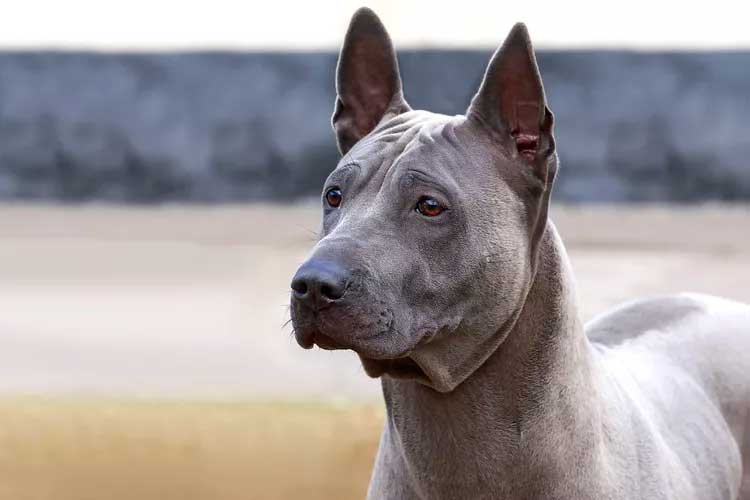
Thai Ridgeback Overview
| OFFICIAL NAME | Thai Ridgeback |
| COMMON NAME | Thai Ridgeback |
| PET HEIGHT | 20 to 24 inches |
| PET WEIGHT | 35 to 70 pounds |
| LIFESPAN | 12 to 13 years |
| GOOD WITH | families |
| TEMPERAMENT | playful, willful |
| INTELLIGENCE | high |
| SHEDDING AMOUNT | normal |
| EXERCISE NEEDS | high |
| ENERGY LEVEL | active |
| VOCAL LEVEL | when necessary |
| DROOL AMOUNT | low |
| BREED GROUP | none |
| BREED SIZE | medium (26-60 lbs.) |
| COAT LENGTH | short |
| COLORS | black, blue, gold / yellow, red |
| OTHER TRAITS | easy to groom, high prey drive, hot weather tolerant, strong loyalty tendencies, tolerates being alone |
The clever, active, and agile Thai ridgeback is a native of eastern Thailand where she was originally bred as a hunter and guardian. This medium- to large-size dog—known for having a ridge pattern on her back—is a muscular natural athlete who relishes (and requires!) regular exercise.
While properly trained and socialized Thai Ridgebacks can be loyal and affectionate family dogs, their historic duties might cause them to be uneasy around unfamiliar faces. The pups are still rare household pets in the United States and are best for experienced dog owners.
Appearance
The Thai ridgeback breed is known for having a mohawk-like strip that runs down their spine—a feature formed by hair growing in the opposite direction of the rest of their coat. The pups share this hallmark trait with their distant hound cousins: the Phu Quoc ridgeback and Rhodesian ridgeback. The Thai ridgeback can be born with one of eight different ridge patterns … or without their namesake characteristic entirely!
A Thai ridgeback's weight can range between 35–75 pounds with females typically clocking in about 20 pounds lighter than males. The medium- and large-size pups stand between 20–24 inches tall. An athletic build; wedge-shaped heads; perky, triangular-shaped ears; and upward-pointing or slightly curved tails give the breed an elegant appearance—and lots of admirers.
Thai ridgebacks can be solid blue, black, fawn, red, or red with a black-masked face. Blessed with a smooth coat, the breed doesn't require much regular grooming—but that doesn't mean you never need to brush her.
Temperament
The Thai ridgeback—originally bred in eastern Thailand as a hunting partner and watchdog—is a quick-witted breed. Because of their historic guarding duties, the pups are incredibly loyal and affectionate companions to family members they trust."The Thai ridgeback is an athletic, intelligent breed that can be both an ideal family dog and an active companion," says Nicole Ellis, CPDT-KA, pet lifestyle expert with Rover.
After many decades of selective breeding to be watchful guardians of shop carts and homes in rural Thailand, this breed may find the sudden approach of unfamiliar animals and humans alarming—and they might share that concern vocally. Behaviors like barking and growling are often rooted in fear of the unknown, so great care and patience should be given when introducing your furry BFF to anything new.
"They can be wary of strangers at first ... because they're cautious," says Julie Burgess, CPDT-KA, a long-time veterinarian technician and certified dog trainer for SeniorTailWaggers.com. "They are incredibly affectionate with families, although just like with any dog, they should be monitored carefully around children."
While Thai ridgebacks can be trained and socialized properly to live happily with other dogs and young children, they do best in homes without cats. And because of their size and muscular build, these four-legged athletes also relish an active lifestyle and require daily exercise.
Living Needs
Thai ridgebacks can be happy anywhere, from large homes with big fenced-in yards to small apartments. That is, as long as their pup parents give them frequent opportunities to work out their physical (and mental!) energy."These dogs, like many, need a job," Burgess says. "For example, they need toys that will keep them mentally stimulated. When dogs have these needs, they can [develop undesirable behaviors] if you don't keep them busy."
The agile Thai ridgeback loves the outdoors, making her an ideal pet for households that enjoy activities like long walks, running, and hiking in the great outdoors. Because the breed's hunting and guarding instincts can make squirrels and rabbits seem like fun animals to chase, they should always be leashed when out and about, especially in unfenced areas and on trails.
But before venturing outside with your ridgeback, check the weather forecast. The breed has a thin coat and is also accustomed to Southeast Asia's hot and humid climate, meaning they prefer warmer temperatures. "They don't have a coat for cold weather and do best in milder environments," Ellis says.

At home, a Thai ridgeback can live in harmony with other dogs as long as she receives proper training and socialization. But remember: Each dog is different, and owners should take the proper steps when introducing any new canine family members.
These dogs prefer the solo company of trusted family members, making them affable housemates but potential wallflowers. Thai ridgebacks may find interacting with two- and four-legged creatures they don't know stressful, stemming from centuries of breeding with the aim of creating a self-sufficient but devoted companion. Their independent personality also means they don't mind being left alone at home for short periods of time, but be sure to keep an eye out for signs of separation anxiety.
Care
Thai ridgebacks are very smart dogs and can pick up training cues quickly. However, this breed requires a patient, thoughtful companion and consistent training to make them excellent family members. As a result, they are best for experienced dog owners (not first-timers), Burgess says, and you should always use positive reinforcement training. Pup parents can also choose to recruit the expertise of a trainer who understands the breed's behavior."Training that rewards behaviors that you'd like your dog to repeat with praise, treats, or play is an excellent way to learn," Burgess says. "Thai ridgebacks are incredibly playful, so they will appreciate playtime more than praise alone."
Regular exercise is also a must for the Thai ridgeback care, ideally 90–120 minutes per day, Burgess says. And while she'll love the aforementioned walks and hikes, a ridgeback will also be content with a game of fetch in the backyard.
The Thai ridgeback's smooth, short coat is fairly easy to maintain, meaning she doesn't require frequent haircuts like long-haired breeds. But the pups should be brushed regularly, which helps stimulate their circulation and coat's natural oil production to keep it healthy and glossy, says Janet Rabbie, a 15-year veteran of the dog-grooming industry and the owner of Wow Grooming in London.

Rabbie also says a Thai ridgeback will shed a couple of times a year. When this happens, she recommends bathing them using a natural, aloe-infused hypoallergenic shampoo and brushing them with Zoom Groom. "[The tool] is a rubber brush which gives an additional helping hand to remove shedding hair while at the same time massaging the skin," she says.
And, as with all dogs, regular nail trims, ear cleanings, and teeth brushing is all part of keeping a ridgeback healthy.
To be their healthiest and happiest, the Thai ridgeback requires the proper amount of high-quality dog food. Consult your veterinarian on how much to feed your Thai ridgeback; the amount will depend on the individual dog's size, age, lifestyle (exercise and energy levels), health conditions, and other factors. No matter what their diet is, dogs should also always have access to clean, fresh water to ensure they can stay hydrated.
Health
Thai ridgeback life expectancy ranges between 12–13 years. They aren't prone to many health conditions, but hip dysplasia can be a concern, Burgess says. Hip dysplasia is a deformity that results in joint laxity, or looseness, and can lead to pain, mobility issues, and osteoarthritis. She says working with a responsible Thai ridgeback breeder can minimize this impact.Dermoid sinus cysts—a skin defect caused by improper formation of tubular cysts that help to drain out dead cells, tissue, and hair—are also common in the breed. "You can find these dermoid cysts in puppies as young as 3–5 weeks in the swirl pattern on their backs, but it is often difficult to detect," Burgess says. "Monitoring the cysts for inflammation is the best way to minimize this health concern."
History
The origin of the Thai ridgeback is a bit murky, but the dogs can be traced back more than 350 years, according to archeological documents found in Thailand. While the canine was originally bred for hunting in the eastern part of the country, residents also used them as companions and guard dogs for their homes and carts, according to the Association for Thai Ridgeback Owners and Fanciers.Thai ridgebacks (also called Mah Thai Lung Ahn in their native language) are not yet recognized by the American Kennel Club, but they are a part of the organization's Foundation Stock Service, which puts them on the path to official breed recognition. The United Kennel Club recognized the Thai ridgeback in 1996.
Fun Facts
Thai Ridgeback dogs can have spotted, blue, or black tongues.While the breed has yet to receive top honors at any widely recognized dog shows in the United States, a Thai ridgeback named Mark won first place for his eponymous breed group for the third year in a row at the World Dog Show in Moscow in 2016.
The canines are known to protect their owners from cobras. In fact, a Thai ridgeback named Phetch in Udon Thani (a city in northeastern Thailand) was caught in a standoff with a three-foot-long cobra in 2020. The snake spit venom at the brave pooch, who alerted his owner about the danger. Phetch provoked the cobra to retreat into a bush, where the reptile was captured by animal control.